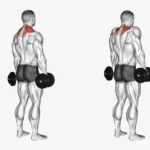Lat Pulldown: Exercise Overview
The lat pulldown is a highly effective exercise designed to strengthen and develop the muscles of the back, with a primary focus on the latissimus dorsi (lats). It also engages the biceps, rhomboids, and trapezius as secondary muscles, contributing to overall upper-body strength and aesthetics. The back benefits from varied training stimuli, so experimenting with different grip widths, hand positions, and angles can optimize muscle growth and development (Schoenfeld, 2010). This versatile movement is ideal for back-focused workouts, upper-body sessions, pull routines, or full-body training programs, supporting both functional strength and a well-defined physique.
How to Perform the Lat Pulldown
- Adjust the lat pulldown machine by attaching a wide-grip handle and setting the thigh pad to secure your body in place.
- Sit on the machine with your feet flat on the floor, grasping the handle with a pronated (overhand) grip, hands slightly wider than shoulder-width.
- Depress your shoulder blades (pull them down) to initiate the movement, then bend your elbows and pull the handle toward your upper chest, keeping your torso upright.
- Pause briefly when your elbows align with your torso, ensuring the handle is close to your chest.
- Slowly return the handle to the starting position with control, allowing your arms to extend fully and your shoulders to slightly elevate.
- Repeat for the desired number of repetitions.
Tips for Optimal Performance
- Engage Your Core: Maintain slight tension in your abdominal muscles to prevent excessive arching of the spine, protecting your lower back during the pull (McGill, 2010).
- Control the Movement: Avoid using momentum by pulling and releasing the handle slowly, ensuring the lats remain engaged throughout each rep (Schoenfeld, 2016).
- Adjust Grip for Comfort: If you feel excessive bicep activation, try a thumbless (false) grip to shift focus to the back muscles.
- Maintain Proper Head Position: Keep your head neutral and avoid jutting it forward to reduce neck strain and maintain spinal alignment.
- Allow Shoulder Blade Movement: Let your shoulder blades move naturally—depressing them as you pull and slightly elevating at the top—to maximize lat engagement and avoid locking the scapulae (Wirth et al., 2016).
- Breathe Properly: Inhale as you return to the starting position and exhale as you pull the handle down to support controlled movement and muscle oxygenation.
Strengthening your lats with pulldowns? Discover how to train your entire back in our Ultimate Guide to Muscle Groups.







